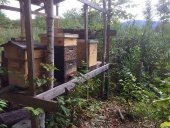




Once you make a decision, the universe conspires to make it happen. - Ralph Waldo Emerson




 4
4




find religion! church
kiva! hyvä! iloinen! pikkumaatila
get stung! beehives
be hospitable! host-a-hive
be antisocial! facespace




Once you make a decision, the universe conspires to make it happen. - Ralph Waldo Emerson





Andrea Locke wrote:According to what I see on the internet, the advice for external use appears to be that about 5 coats of tung oil should be applied and the dry time would be about 2-3 days per coat. Does that sound right?
Andrea Locke wrote:What I have on hand is straight tung oil, not mixed with a varnish. Is an annual touchup of tung oil required? I assume that should be done with the box removed from the hive rather than with the bees in residence? In which case I guess I'd need a spare box so as to be able to swap them out when touchups are needed.
find religion! church
kiva! hyvä! iloinen! pikkumaatila
get stung! beehives
be hospitable! host-a-hive
be antisocial! facespace




Once you make a decision, the universe conspires to make it happen. - Ralph Waldo Emerson




Dr Leo Sharashkin
Beekeeper and Editor
HorizontalHive.com
 3
3




Once you make a decision, the universe conspires to make it happen. - Ralph Waldo Emerson

|
Fire me boy! Cool, soothing, shameless self promotion:
Permaculture Design Magazine
https://permies.com/wiki/237407/permaculture/Permaculture-Design-Magazine
|



